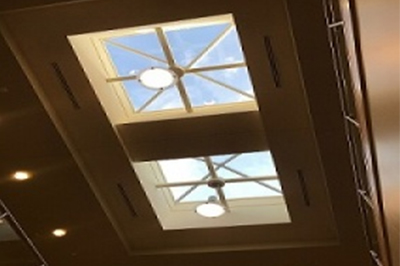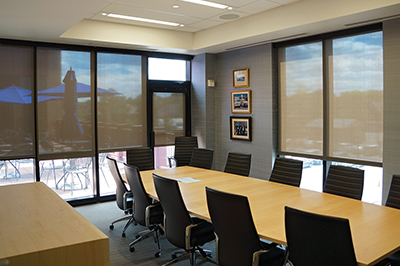Windows
Windows
Amount of Walls with Windows (AW/W)
From the supporting literature (linked above), the benefit of providing daylighting through windows in classrooms on students performance is discussed. The presence, size, and number of windows in a classroom relative to the amount of walls influence classroom lighting. There is consistency among researchers that windows should not be absent in classrooms, and that the design for classrooms should maximize natural lighting through windows and skylights. An association between natural lighting in classrooms, and students behavior and performance has also been noted.
Recommendations
1. Maximize natural light potentials through building orientation.
2. The number of walls to windows in a classroom should be such that allows maximum penetration of daylighting in the classroom.
3. Reduces heat gain and energy demand in classrooms by optimizing natural lighting.
4. Advocate Integrated building designs with mechanical system sorting and building systems synergy.
5. Use artificial lighting to complement natural lighting.
6. Classrooms should be of moderate illumination, not low and not too bright (high).
7. In the design for classrooms, consider the number of walls to windows that make proper illumination.
8. Optimize natural lighting in classrooms through building design, and doors and window orientation.
9. Ensure that the space facing the window is not obstructed.
10. Consider the effect of BUG in determining the appropriate amount of walls to windows in classrooms.
Dimension of Windows (DW)
From the supporting literature (linked above), There is a relationship between the provided amount of lighting through provided windows in classrooms.
Recommendations
1. Ensure that the provided windows and doors maximize penetration of natural light.
2. Optimize natural lighting in classrooms through building design, and doors and window orientation.
3. Placement and selection of doors and window sizes should be such that maximizes natural lighting.
4. Ensure that the space facing the window is not obstructed.
5. Use artificial lighting to complement natural light.
Skylight
The existence of any other opening like a window in the roof or ceiling.
From the supporting literature (linked above), there is a benefit of providing daylight through skylights on student performance and well-being.
Lights provided through skylights in the building affects classroom temperature and lighting. It also adds to classroom aesthetic view. There is a strong relationship between classroom lighting and thermal comfort.
Recommendations
1. Reduce classroom energy consumption by providing skylights.
2. Optimize natural lighting in classroom design by providing skylights.
Windows Blocked (WB)
The existence of elements which block the daylight in a room.
References
1. Barrett, Peter; Zhang, Yufan; Moffat, Joanne; Kobbacy, Khairy (2013). “A Holistic, Multi-level Analysis Identifying the Impact of Classroom Design on Pupils’ Learning”. Building and Environment, 59, 678-689.
2. Barrett, Peter; Fay Davies; Yufan Zhang; Lucinda Barrett (2015). “The Impact of Classroom Design on Pupils’ Learning: Final Results of a Holistic, Multi-level Analysis”. Building and Environment, 89, 118-133.
3. Blackmore, J; Bateman, D; Loughlin, J; O’Mara, J; Aranda, G; Centre for Re (2011). “Research into the Connection Between Built Learning Spaces and Student Outcomes: Literature Review”. Department of Education and Early Childhood Development, State of Victoria.
4. Blincoe, J.M (2008) The Age and Condition of Texas High Schools as Related to Student Academic Achievement. College of Education, University of Texas at Austin.
4. Earthman, G. I. (2004). “Prioritization of 31 Criteria for School Building Adequacy.” American Civil Liberties Union Foundation of Maryland. Retrieved in 2016 from http://www.schoolfunding.info/policy/facilities/ACLUfacilities_report1-04.pdf, Baltimore, MD.
5. Edwards, L, and Torcellini, P (2002). “A Literature Review of the Effects of Natural Light on Building Occupants” National Renewable Energy Laboratory, Colorado NREL/TP-550-30769.
6. Heschong L. (1999). “Daylighting in Schools: An Investigation into the Relationship Between Daylighting and Human Performance (HMG Project #9803)”. Heschong Mahone Group to Pacific Gas and Electric Company on behalf of the California Board for Energy Efficiency Third Party Program. <http://files.eric.ed.gov/fulltext/ED444337.pdf> (May 16, 2016).
7. Kyungah Choi; Hyeon-Jeong Suk (2016) “Dynamic lighting system for the learning environment: performance of elementary students”. Optics Express, 24(10), A907-A916
8. Michael S. Mott; Daniel H. Robinson; Ashley Walden, Jodie Burnette, Angela S. Rutherford (2012)
9. Mott, M. S., Robinson, D. H., Walden, A., Burnette, J., & Rutherford, A. S. (2012). Illuminating the effects of dynamic lighting on student learning. Sage Open, 2(2), 2158244012445585.
10. Nicklas, M. H., and Bailey, G. B. (1996). “Student performance in daylit schools.” Innovative Design. Raleigh, North Carolina.
11. Pereira, L. D., Raimondo, D., Corgnati, S. P., & da Silva, M. G. (2014). Assessment of indoor air quality and thermal comfort in Portuguese secondary classrooms: methodology and results. Building and environment, 81, 69-80.
12. Plympton P., Conway S. Epstein K. (2000). “Day lightening in schools: improving student performance and health at a price school can afford”, NREL/CP-550-28049, National Renewable Energy Laboratory, USA.
13. Tanner, C. K. (2009). Effects of school design on student outcomes. Journal of Educational Administration, 47(3), 381-399.







